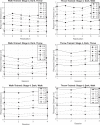Visually directed action
- PMID: 34019620
- PMCID: PMC8142698
- DOI: 10.1167/jov.21.5.25
Visually directed action
Abstract
When people throw or walk to targets in front of them without visual feedback, they often respond short. With feedback, responses rapidly become approximately accurate. To understand this, an experiment is performed with four stages. 1) The errors in blind walking and blind throwing are measured in a virtual environment in light and dark cue conditions. 2) Error feedback is introduced and the resulting learning measured. 3) Transfer to the other response is then measured. 4) Finally, responses to the perceived distances of the targets are measured. There is large initial under-responding. Feedback rapidly makes responses almost accurate. Throw training transfers completely to walking. Walk training produces a small effect on throwing. Under instructions to respond to perceived distances, under-responding recurs. The phenomena are well described by a model in which the relation between target distance and response distance is determined by a sequence of a perceptual, a cognitive, and a motor transform. Walk learning is primarily motor; throw learning is cognitive.
Figures






References
-
- Da Silva, J. A. (1985). Scales for perceived egocentric distance in a large open-field: Comparison of 3 psychophysical methods. American Journal of Psychology , 98(1), 119–144. - PubMed
Publication types
MeSH terms
LinkOut - more resources
Full Text Sources
Other Literature Sources

